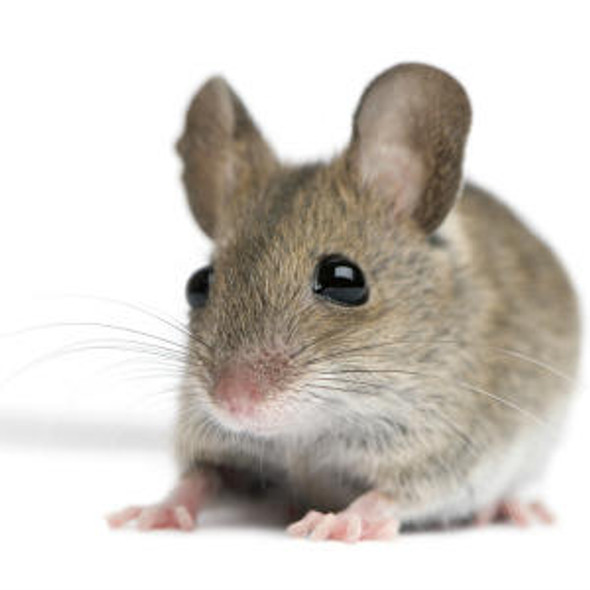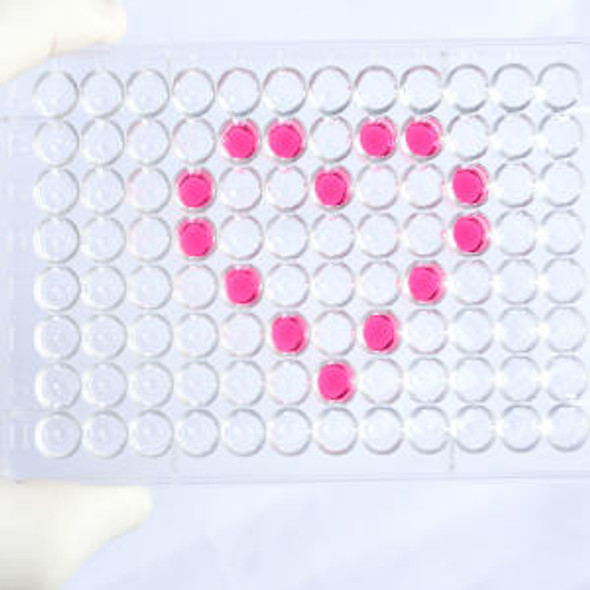Rat Signal transducer and activator of transcription 3 (Stat3) ELISA Kit (RTEB1184)
- SKU:
- RTEB1184
- Product Type:
- ELISA Kit
- Size:
- 96 Assays
- Uniprot:
- P52631
- Range:
- 0.156-10 ng/mL
- ELISA Type:
- Sandwich
- Synonyms:
- Stat3, Signal transducer and activator of transcription 3
- Reactivity:
- Rat
Description
Rat Signal transducer and activator of transcription 3 (Stat3) ELISA Kit
The Rat Signal Transducer and Activator of Transcription 3 (STAT3) ELISA Kit is a powerful tool for the quantification of STAT3 levels in rat samples including serum, plasma, and cell culture supernatants. This kit offers exceptional sensitivity and specificity, allowing for accurate and consistent results to be obtained for a variety of research applications.STAT3 is a key transcription factor that plays a critical role in mediating cellular responses to a variety of signaling pathways. Dysregulation of STAT3 activity has been implicated in various diseases including cancer, inflammation, and autoimmune disorders, making it a valuable target for research and drug development.
By using the Rat STAT3 ELISA Kit, researchers can gain insight into the activation status of STAT3 in different disease models and study its potential as a therapeutic target. With its reliable performance and user-friendly protocol, this kit is an essential tool for investigating the role of STAT3 in various physiological and pathological processes in rats.
| Product Name: | Rat Signal transducer and activator of transcription 3 (Stat3) ELISA Kit |
| SKU: | RTEB1184 |
| Size: | 96T |
| Target: | Rat Signal transducer and activator of transcription 3 (Stat3) |
| Synonyms: | Signal transducer and activator of transcription 3, Stat3 |
| Assay Type: | Sandwich |
| Detection Method: | ELISA |
| Reactivity: | Rat |
| Detection Range: | 0.156-10ng/mL |
| Sensitivity: | 0.082ng/mL |
| Intra CV: | 5.5% | ||||||||||||||||||||
| Inter CV: | 10.2% | ||||||||||||||||||||
| Linearity: |
| ||||||||||||||||||||
| Recovery: |
| ||||||||||||||||||||
| Function: | Signal transducer and transcription activator that mediates cellular responses to interleukins, KITLG/SCF, LEP and other growth factors. Once activated, recruits coactivators, such as NCOA1 or MED1, to the promoter region of the target gene. May mediate cellular responses to activated FGFR1, FGFR2, FGFR3 and FGFR4. Binds to the interleukin-6 (IL-6)-responsive elements identified in the promoters of various acute-phase protein genes. Activated by IL31 through IL31RA. Acts as a regulator of inflammatory response by regulating differentiation of naive CD4(+) T-cells into T-helper Th17 or regulatory T-cells (Treg): deacetylation and oxidation of lysine residues by LOXL3, leads to disrupt STAT3 dimerization and inhibit its transcription activity. Involved in cell cycle regulation by inducing the expression of key genes for the progression from G1 to S phase, such as CCND1 (By similarity). Mediates the effects of LEP on melanocortin production, body energy homeostasis and lactation (By similarity). May play an apoptotic role by transctivating BIRC5 expression under LEP activation. Cytoplasmic STAT3 represses macroautophagy by inhibiting EIF2AK2/PKR activity. |
| Uniprot: | P52631 |
| Sample Type: | Serum, plasma, tissue homogenates, cell culture supernates and other biological fluids |
| Specificity: | Natural and recombinant rat Signal transducer and activator of transcription 3 |
| Sub Unit: | Forms a homodimer or a heterodimer with a related family member (at least STAT1). Interacts with IL31RA, NCOA1, PELP1, SIPAR, SOCS7, STATIP1 and TMF1. Interacts with IL23R in presence of IL23. Interacts (via SH2 domain) with NLK. Interacts with ARL2BP; the interaction is enhanced by LIF and JAK1 expression (By similarity). Interacts with KPNA4 and KPNA5; KPNA4 may be the primary mediator of nuclear import (By similarity). Interacts with CAV2; the interaction is increased on insulin-induced tyrosine phosphorylation of CAV2 and leads to STAT3 activation (PubMed:19427337). Interacts with ARL2BP; interaction is enhanced with ARL2. Interacts with NEK6 (By similarity). Binds to CDK9 when activated and nuclear. Interacts with BMX. Interacts with ZIPK/DAPK3. Interacts with PIAS3; the interaction occurs on stimulation by IL6, CNTF or OSM and inhibits the DNA binding activity of STAT3. In prostate cancer cells, interacts with STAT3 and promotes DNA binding activity of STAT3. Interacts with STMN3, antagonizing its microtubule-destabilizing activity. Interacts with the 'Lys-129' acetylated form of BIRC5/survivin. Interacts with FER. Interacts (via SH2 domain) with EIF2AK2/PKR (via the kinase catalytic domain) (By similarity). Interacts with FGFR4 (By similarity). Interacts with STAT3; the interaction is independent of STAT3 TYR-705 phosphorylation status. |
| Research Area: | Cancer |
| Subcellular Location: | Cytoplasm Nucleus Shuttles between the nucleus and the cytoplasm. Translocated into the nucleus upon tyrosine phosphorylation and dimerization, in response to signaling by activated FGFR1, FGFR2, FGFR3 or FGFR4. Constitutive nuclear presence is independent of tyrosine phosphorylation. Predominantly present in the cytoplasm without stimuli. Upon leukemia inhibitory factor (LIF) stimulation, accumulates in the nucleus. The complex composed of BART and ARL2 plays an important role in the nuclear translocation and retention of STAT3 (By similarity). |
| Storage: | Please see kit components below for exact storage details |
| Note: | For research use only |
| UniProt Protein Function: | STAT3: transcription factor of the STAT family. Phosphorylated and activated by receptor-associated kinases downstream of many cytokines and growth-factor receptors. Constitutively active in a number of human tumors. Forms homo- or heterodimers that translocate into the nucleus where they regulate transcription. Two alternatively spliced isoforms have been described. |
| UniProt Protein Details: | Protein type:DNA-binding; Motility/polarity/chemotaxis; Nuclear receptor co-regulator; Transcription factor Chromosomal Location of Human Ortholog: 10q31 Cellular Component: cytoplasm; cytosol; mitochondrial inner membrane; mitochondrion; nuclear chromatin; nucleoplasm; nucleus; plasma membrane Molecular Function:CCR5 chemokine receptor binding; chromatin DNA binding; DNA binding; glucocorticoid receptor binding; identical protein binding; ligand-dependent nuclear receptor activity; protein binding; protein dimerization activity; protein kinase binding; protein phosphatase binding; sequence-specific DNA binding; transcription factor activity; transcription factor binding Biological Process: acute-phase response; aging; astrocyte differentiation; cell proliferation; cellular response to hormone stimulus; eating behavior; eye photoreceptor cell differentiation; glucose homeostasis; intracellular receptor-mediated signaling pathway; JAK-STAT cascade; leptin-mediated signaling pathway; miRNA-mediated gene silencing, negative regulation of translation; mRNA transcription from RNA polymerase II promoter; negative regulation of apoptosis; negative regulation of cell proliferation; negative regulation of glycolysis; phosphorylation; positive regulation of cell proliferation; positive regulation of Notch signaling pathway; positive regulation of transcription from RNA polymerase II promoter; positive regulation of transcription, DNA-dependent; protein import into nucleus; radial glial cell differentiation; regulation of cell cycle; regulation of mitochondrial membrane permeability; regulation of multicellular organism growth; regulation of transcription from RNA polymerase II promoter; regulation of transcription, DNA-dependent; response to cytokine stimulus; response to drug; response to estradiol stimulus; response to ethanol; response to organic cyclic substance; response to organic substance; response to peptide hormone stimulus; sexual reproduction; stem cell maintenance; thermoregulation; transcription from RNA polymerase II promoter |
| NCBI Summary: | transcription factor that plays a role in induction of gene expression during acute phase response [RGD, Feb 2006] |
| UniProt Code: | P52631 |
| NCBI GenInfo Identifier: | 6981592 |
| NCBI Gene ID: | 25125 |
| NCBI Accession: | NP_036879.1 |
| UniProt Related Accession: | P52631 |
| Molecular Weight: | 88,040 Da |
| NCBI Full Name: | signal transducer and activator of transcription 3 |
| NCBI Synonym Full Names: | signal transducer and activator of transcription 3 |
| NCBI Official Symbol: | Stat3 |
| NCBI Protein Information: | signal transducer and activator of transcription 3 |
| UniProt Protein Name: | Signal transducer and activator of transcription 3 |
| Protein Family: | Signal transducer and activator of transcription |
| UniProt Gene Name: | Stat3 |
| Component | Quantity (96 Assays) | Storage |
| ELISA Microplate (Dismountable) | 8×12 strips | -20°C |
| Lyophilized Standard | 2 | -20°C |
| Sample Diluent | 20ml | -20°C |
| Assay Diluent A | 10mL | -20°C |
| Assay Diluent B | 10mL | -20°C |
| Detection Reagent A | 120µL | -20°C |
| Detection Reagent B | 120µL | -20°C |
| Wash Buffer | 30mL | 4°C |
| Substrate | 10mL | 4°C |
| Stop Solution | 10mL | 4°C |
| Plate Sealer | 5 | - |
Other materials and equipment required:
- Microplate reader with 450 nm wavelength filter
- Multichannel Pipette, Pipette, microcentrifuge tubes and disposable pipette tips
- Incubator
- Deionized or distilled water
- Absorbent paper
- Buffer resevoir
*Note: The below protocol is a sample protocol. Protocols are specific to each batch/lot. For the correct instructions please follow the protocol included in your kit.
Allow all reagents to reach room temperature (Please do not dissolve the reagents at 37°C directly). All the reagents should be mixed thoroughly by gently swirling before pipetting. Avoid foaming. Keep appropriate numbers of strips for 1 experiment and remove extra strips from microtiter plate. Removed strips should be resealed and stored at -20°C until the kits expiry date. Prepare all reagents, working standards and samples as directed in the previous sections. Please predict the concentration before assaying. If values for these are not within the range of the standard curve, users must determine the optimal sample dilutions for their experiments. We recommend running all samples in duplicate.
| Step | |
| 1. | Add Sample: Add 100µL of Standard, Blank, or Sample per well. The blank well is added with Sample diluent. Solutions are added to the bottom of micro ELISA plate well, avoid inside wall touching and foaming as possible. Mix it gently. Cover the plate with sealer we provided. Incubate for 120 minutes at 37°C. |
| 2. | Remove the liquid from each well, don't wash. Add 100µL of Detection Reagent A working solution to each well. Cover with the Plate sealer. Gently tap the plate to ensure thorough mixing. Incubate for 1 hour at 37°C. Note: if Detection Reagent A appears cloudy warm to room temperature until solution is uniform. |
| 3. | Aspirate each well and wash, repeating the process three times. Wash by filling each well with Wash Buffer (approximately 400µL) (a squirt bottle, multi-channel pipette,manifold dispenser or automated washer are needed). Complete removal of liquid at each step is essential. After the last wash, completely remove remaining Wash Buffer by aspirating or decanting. Invert the plate and pat it against thick clean absorbent paper. |
| 4. | Add 100µL of Detection Reagent B working solution to each well. Cover with the Plate sealer. Incubate for 60 minutes at 37°C. |
| 5. | Repeat the wash process for five times as conducted in step 3. |
| 6. | Add 90µL of Substrate Solution to each well. Cover with a new Plate sealer and incubate for 10-20 minutes at 37°C. Protect the plate from light. The reaction time can be shortened or extended according to the actual color change, but this should not exceed more than 30 minutes. When apparent gradient appears in standard wells, user should terminatethe reaction. |
| 7. | Add 50µL of Stop Solution to each well. If color change does not appear uniform, gently tap the plate to ensure thorough mixing. |
| 8. | Determine the optical density (OD value) of each well at once, using a micro-plate reader set to 450 nm. User should open the micro-plate reader in advance, preheat the instrument, and set the testing parameters. |
| 9. | After experiment, store all reagents according to the specified storage temperature respectively until their expiry. |
When carrying out an ELISA assay it is important to prepare your samples in order to achieve the best possible results. Below we have a list of procedures for the preparation of samples for different sample types.
| Sample Type | Protocol |
| Serum | If using serum separator tubes, allow samples to clot for 30 minutes at room temperature. Centrifuge for 10 minutes at 1,000x g. Collect the serum fraction and assay promptly or aliquot and store the samples at -80°C. Avoid multiple freeze-thaw cycles. If serum separator tubes are not being used, allow samples to clot overnight at 2-8°C. Centrifuge for 10 minutes at 1,000x g. Remove serum and assay promptly or aliquot and store the samples at -80°C. Avoid multiple freeze-thaw cycles. |
| Plasma | Collect plasma using EDTA or heparin as an anticoagulant. Centrifuge samples at 4°C for 15 mins at 1000 × g within 30 mins of collection. Collect the plasma fraction and assay promptly or aliquot and store the samples at -80°C. Avoid multiple freeze-thaw cycles. Note: Over haemolysed samples are not suitable for use with this kit. |
| Urine & Cerebrospinal Fluid | Collect the urine (mid-stream) in a sterile container, centrifuge for 20 mins at 2000-3000 rpm. Remove supernatant and assay immediately. If any precipitation is detected, repeat the centrifugation step. A similar protocol can be used for cerebrospinal fluid. |
| Cell culture supernatant | Collect the cell culture media by pipette, followed by centrifugation at 4°C for 20 mins at 1500 rpm. Collect the clear supernatant and assay immediately. |
| Cell lysates | Solubilize cells in lysis buffer and allow to sit on ice for 30 minutes. Centrifuge tubes at 14,000 x g for 5 minutes to remove insoluble material. Aliquot the supernatant into a new tube and discard the remaining whole cell extract. Quantify total protein concentration using a total protein assay. Assay immediately or aliquot and store at ≤ -20 °C. |
| Tissue homogenates | The preparation of tissue homogenates will vary depending upon tissue type. Rinse tissue with 1X PBS to remove excess blood & homogenize in 20ml of 1X PBS (including protease inhibitors) and store overnight at ≤ -20°C. Two freeze-thaw cycles are required to break the cell membranes. To further disrupt the cell membranes you can sonicate the samples. Centrifuge homogenates for 5 mins at 5000xg. Remove the supernatant and assay immediately or aliquot and store at -20°C or -80°C. |
| Tissue lysates | Rinse tissue with PBS, cut into 1-2 mm pieces, and homogenize with a tissue homogenizer in PBS. Add an equal volume of RIPA buffer containing protease inhibitors and lyse tissues at room temperature for 30 minutes with gentle agitation. Centrifuge to remove debris. Quantify total protein concentration using a total protein assay. Assay immediately or aliquot and store at ≤ -20 °C. |
| Breast Milk | Collect milk samples and centrifuge at 10,000 x g for 60 min at 4°C. Aliquot the supernatant and assay. For long term use, store samples at -80°C. Minimize freeze/thaw cycles. |










